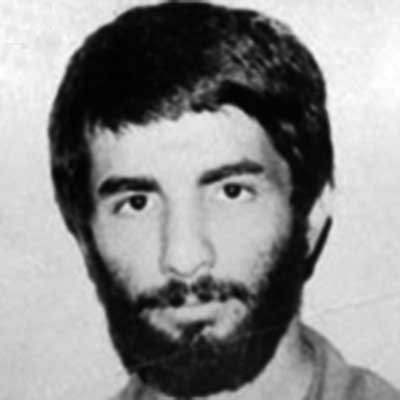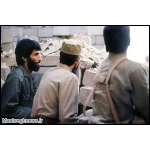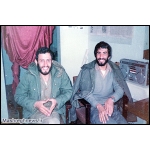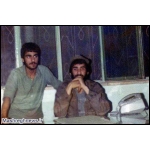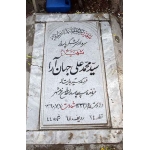Jahanara, Sayyed Mohammad Ali
Leila Haideri Bateni
562 بازدید
Sayyed Mohammad Ali Jahanara (1954-1981) was a commander in the Islamic Revolutionary Guards (IRGC) in Khorramshahr and Ahvaz. After breaking the siege of Abadan in Operation Thamin al-A’imma, he tragically lost his life and was martyred in a plane accident over Kahrizak; he was returning to Tehran.
Sayyed Mohammad Ali Jahanara was born on August 31, 1954, in Khorramshahr. At the tender age of thirteen, Jahanara began participating in religious gatherings at his local mosque. A year later, at the advisement of his brother Sayyed Ali, Jahanara joined the political group Hezbollah of Khorramshahr. The group came under SAVAK’s radar and, in 1972, several members of this group, including Mohammad, were arrested. Jahanara personally spent a year imprisoned.
In 1975, after obtaining his diploma and passing the national university entrance exam, he enrolled in the Faculty of Management at the Tabriz School of Commerce. There, he continued his political activities and became a founding member of the university’s Islamic Association. In 1976, Jahanara dropped out of university and joined the religious Mansooroon, a religious group that was inclined towards armed tendencies.[1] One notable activity that this group carried out was transporting weapons from Tehran to Ahvaz in 1977. After the martyrdom of his brother Seyyed Ali, Jahanara intensified his struggle through guerrilla and armed resistance.
Following the victory of the Islamic Revolution in 1979, Jahanara returned to Khorramshahr. To safeguard the revolution, he established the Revolutionary Military Cultural Center of Khorramshahr. He established this center with assistance from his friends. After its establishment, he assumed responsibility for its military wing. This group was formed to counteract the separatist Arab People’s Party which was supported by the Baa’th Party in Iraq.[2]
In 1979, Jahanara married Soghra Akbarnejad, and their union resulted in two sons: Hamzeh and Mohammad Salman, born one month after his father’s martyrdom.[3] The formation of the Sepah-e Pasdaran in Khorramshahr initially involved forces dispatched from Tehran. However, following the violent clashes with the Arab People’s Party in May of 1979 – where the Baa’th Party and local clerics, including Sheikh Mohammad Taher Shobeiri Al-Khaqani, orchestrated destructive acts, bombings, and armed demonstrations – the Pasdaran recruited local forces[4]. In 1980, the previously dispatched group from Tehran left, and Mohammad Jahanara became the commander of the IRGC of Khorramshahr.[5]
Jahanara laid the groundwork for developing infrastructure in Khorramshahr, establishing a construction unit within the Pasdaran. The goal of this unit was to address the region’s lack of development. He emphasized negotiation, interaction, dialogue, and control in the fight against the anti-revolutionary elements of the region. His familiarity and friendship with the local Arab population allowed him to collect military intelligence regarding Iraq’s movements around the border.[6] In June and July of 1980, he promptly reported his intelligence to Tehran. Notably, he uncovered the conspiracy of the NEQAB (Nojeh) coup and in June of 1980, he apprehended several conspirators.[7]
As the Iran-Iraq War erupted on September 22, 1980, Mohammad Jahanara, a dedicated commander, swiftly organized the forces of the Khorramshahr division of the IRGC. He mobilized and recruited resistance groups from within the mosques and religious centers. He distributed weapons – including weapons from the Dezh Garrison, responsible for guarding the northern border – to both IRGC fighters and civilian militia. These preparations became crucial for the impending battles on the main and entry fronts of Khorramshahr. He selected about seventy people who had collaborated with the Khorramshahr Revolutionary Military Cultural Center in political, cultural, and law enforcement activities and sent them to Dezful[8] to undergo an intensive fifteen-day military course such as weapons Learning, shooting, individual combat, etc. Therefore, on the first day of the war, he asked them to enter the battlefield.[9]
From the outset, Khorramshahr faced relentless attacks at the hands of the Iraqi army. The city withstood tank assaults, infantry offensives, and heavy artillery bombardments from all directions. The Iraqi forces constantly rained down fire from five different artillery positions. Remarkably, the Khorramshahr resistance fighters – armed primarily with RPG-7s and ZU-23 anti-aircraft guns – stood their ground against overwhelming odds. Jahanara not only organized the forces but he managed the overall strategy and planning for the defense. His leadership was unwavering. In an effort to inspire the resistance fighters, Jahanara said, “Here, it is a matter of survival and martyrdom, Anyone who wishes to leave may do so voluntarily. Only those who have resolved their fate with God can stay back, fight, and resist. Should you choose to stay, draw inspiration from the steadfastness of Imam Hussain’s companions in Karbala.”[10]
Jahanara likened the circumstances in Khorramshahr to the battlefield of Karbala,[11] emphasizing the unwavering faith and conviction of the people in defending their homeland against the enemy occupation. His words resonated deeply with the fighters, reinforcing their determination to hold their ground.[12] Ayatollah Khamenei also praised the resistance in Khorramshahr, stating, “During those days, I was in Ahvaz. I was a witness to these events firsthand. Khorramshahr virtually had no armed forces, and yet Mohammad Jahanara and the other young warriors resisted the invading Iraqi forces – a well-equipped armored division with specialized troops and a battery of 90mm cannons – for thirty-five days. Oh, people of Iran! Have trust in these boys and soldiers!”[13]
In 1981, Jahanara continued his service as the commander of the IRGC in Ahvaz. He oversaw the 8th Regional Command.[14] While he was lodged in Hotel Persian in Abadan, he played a pivotal role in rebuilding the Khorramshahr division. Despite the Council of Commanders of Khorramshahr taking form before the outbreak of the war, he was reappointed through a new council and voting process. He appointed each member of the council to take on a specific responsibility. These included logistics, intelligence, and training;[15] and then through regional operations, they were able to put pressure on the Iraqi army.
As commander of the resistance forces in Khorramshahr, Jahanara maintained a continuous presence on the front lines. Consequently, he can be regarded as a pioneer when it comes to leadership on the frontlines. After the fall of Khorramshahr, he continued his activities in the south, playing a significant role in mobilizing the people of Ahvaz and the surrounding villages in Khuzestan. His contribution on that front included training and preparing the forces. He also involved them in low-level operations following the city’s occupation.[16]
Following the fall of Khorramshahr and the siege of Abadan by the Iraqi forces, Imam Khomeini issued an order on November 5, 1980.[17] In this order, he emphasized the need to break the siege of Abadan. Eleven months later, during Operation Thamin al-A’imma (October 5-6, 1981), the combined forces of the IRGC, the Army, and the Basij forces managed to overwhelm the Iraqi forces, liberating Abadan after 349 days under siege.[18] For Jahanara, who served as the Commander of the Southern Operations and the IRGC of Ahvaz, this victory marked his first major success after the resistance in Khorramshahr.[19]
On October 7, 1981, Mohammad Jahanara, along with several high-ranking officers of the Army and IRGC – including Lieutenant General Valiollah Fallahi (Deputy Chief of Joint Staff), Brigadier General Musa Namjoo (Minster of Defense), Brigadier General Javad Fakoori (Commander of the Air Force) and Brigadier General Yousef Kalahdooz (Deputy Commander of the IRGC) – boarded a C-130 aircraft. They were on their way to Tehran to report on Operation Thamin al-A’imma. However, at 19:59 in the southwestern region of Kahrizak, near Tehran, the aircraft crashed under mysterious circumstances, resulting in the martyrdom of all of the commanders.[20]
The body of Martyr Jahanara was laid to rest in Section 24 of Behesht Zahra Cemetry.[21] In describing these fallen commanders, Imam Khomeini stated, “… they were righteous and trustworthy servants of the nation who, during the Revolution and after it served this Islamic with pride and bravery. May they be embraced in the Mercy of God the Highest.”[22]
On June 3rd, 1982, eight months after the martyrdom of Mohammad Ali Jahanara, Khorramshahr was liberated after Operation Beit al-Moqaddas.[23] The famous poem "Muhammad, you were not there to see that the city liberated..." by Javad Azizi was recited in his elegy.[24] Hussain Fakhri, a fellow combatant, recited that verse at Jahanara’s gravesite, and simultaneously, Gholam Kootipour recited it at the anniversary of Khorramshahr’s liberation.[25]
After his martyrdom, Seyyed Mohammad Ali Jahanara was posthumously promoted to the rank of Major General in the IRGC. Following the conclusion of the war, Arash St. and the Felizi Bridge were renamed after Martyr Jahanara.[26]
Martyr Jahanara’s mother, Sara Imamzadeh, passed away in September 2011, and his father, Hedayatollah Jahanara, in September 2015.[27]
[1] Encyclopedia of the Islamic Revolution, Vol. 2, Tehran: Soure Mehr, third edition, 2012, p. 52.
[2] Ibid., p. 43.
[3] Sarhangi, Morteza, Behboudi, Hedayatollah, Khorramshahr Ko Jahanara, Tehran: Soure Mehr, 8th edition, 2007, pp. 12-19.
[4] Qeysari, Mahdi, Khorram Vali Khonin, Tehran: Islamic Revolution Documents Center, 2005, pp. 15 and 16.
[5] Ibid., p. 132.
[6] Ibid., p. 15.
[7] Encyclopedia of the Islamic Revolution, Vol. 2, pp. 52 and 53.
[8] Qeysari, Mahdi, Khorram Vali Khonin, p. 83; Motlaq, Mohsen, Tekkehee Az Asman: Khorramshahr, Tehran: Foundation for the Preservation of Works and Publication of Sacred Defense Values, 2014, p. 48.
[9] Teymouri, Abbas, Va Amma Khorramshahr, Tehran: Setareha, 2006, p. 83.
[10] Qeysari, Mahdi, Khorram Vali Khonin, p. 59.
[11] Shahed Yaran, vols. 72 and 73, November and December 2011, pp. 13-15.
[12] Ibid,. Pp. 12-14.
[13] Shahed Yaran. P. 3.
[14] Encyclopedia of the Islamic Revolution, Vol. 2, p. 52.
[15] Shahed Yaran. P. 41.
[16] Ibid,. p. 45.
[17] Sahifah Imam, Vol. 13, Tehran: Institute for Compilation and Publication of Imam Khomeini's Works, 1999, p. 333.
[18] Guide Atlas 6: Abadan at War, Tehran: Center for War Studies and Research of the Islamic Revolutionary Guard Corps, 2003, p. 126; Atlas of the Iran-Iraq War, Tehran: Center for Sacred Defense Documents and Research of the Islamic Revolutionary Guard Corps, 3rd edition, 2013, p. 46.
[19] Shahed Yaran. Pp. 67-102
[20] Hosseini, Sayyed Yaqoob and Javadipour, Muhammad, The Army of the Islamic Republic of Iran in Eight Years of Sacred Defense, Vol. 3: The Occupation of Khorramshahr and the Defeat of the Siege of Abadan, Tehran: The Ideological and Political Organization of the Army of the Islamic Republic of Iran, 1994, pp. 282 and 283; Shahed Yaran, p. 11; Jomhoori Eslami Newspaper, No. 674, October 1, 1981, p. 11.
[21] Shahed Yaran. P. 110.
[22] Sahifah Imam. Vol. 15. P. 263.
[23] Encyclopedia of the Islamic Revolution, Vol. 2, pp. 52 and 53.
[24] Shaed Yaran. P. 110.
[25] Electronic archive of the Sacred Defense Encyclopedia, document number 5-98-1367.
[26] Pourjabari, Pejman, Epic Geographic Atlas 1: Khuzestan at War, Foundation for the Preservation of Monuments and the Propagation of Sacred Defense Values, p. 37; Shahed Yaran, p. 93.
[27] Ettelaat Newspaper, September 19, 2015, Year 3, No. 26257, p. 2; Shahed Yaran, p. 29.


